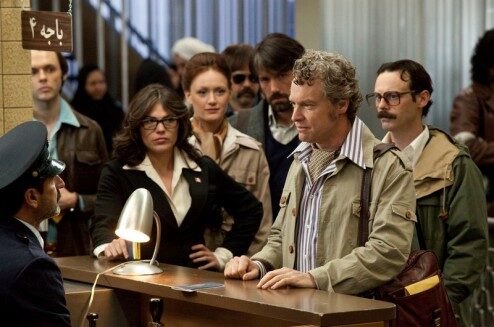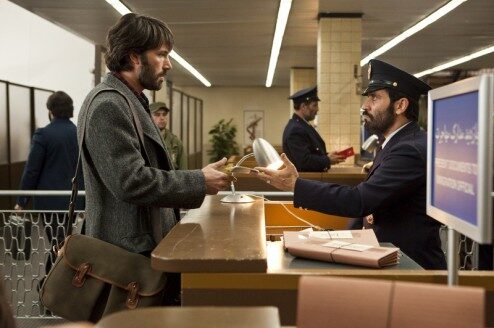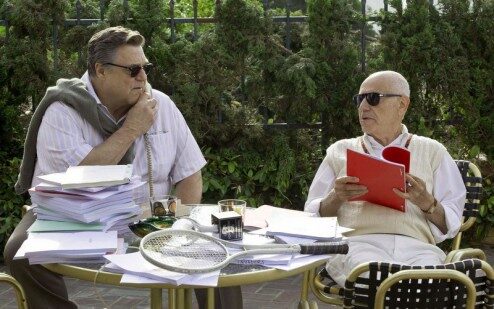Argo: Interview with Costume Designer Jacqueline West |
Jacqueline West is one of the most interesting costume designers we have featured at Clothes on Film. Her credits include The Curious Case of Benjamin Button, The Social Network and most recently Argo directed by Ben Affleck for which she is CDG nominated (Excellence in Period Film). Yet West did not set out to be a costume designer, instead forging a career in fashion during the 1970s. It was not until director Philip Kaufman hired her to assistant costume Henry & June in 1989 that she tentatively entered the profession and then continued to shine, essentially self-taught from books by the one costume designer she had heard of – Edith Head.
Chatting exclusively to Clothes on Film, Jacqueline West talks us through the incredible level of detail and research she undertook for Argo, living up to her status as what Brad Pitt described as a “method costume designer”:
Clothes on Film, Chris: Argo has a nostalgic feel for the late 1970s/early 80’s. Did this extend to your costume design?
Jacqueline West: It’s interesting you said that. We tried so hard not to make this a period piece. I think every department worked at their max to do that for Ben (Affleck). He wanted to make the film look like it was shot then and not now. If just one costume jumped out it was stark comparison. I pored over this book on 1970s filmmaking – everyone from Sydney Pollack to Roger Corman. It’s called The Stewardess is Flying the Plane! by Ron Hogan. Ben wanted a bird’s eye view into something that was happening then. I looked at so many movies with him. One night at his house we screened The Killing of a Chinese Bookie, Three Days of the Condor, The China Syndrome, Charlie’s Angels on television to look at TV and film crews. We looked at The Fall Guy to see them on a studio lot.
There is one thing I can’t take credit for but it was quite brilliant. One day Ben called us into his office and said “can you dress all of the houseguests (those who are trapped in the Embassy house) in 1970s clothing? I’m going to sequester them for a week. No cell phones, only 70’s TV shows and movies.” They were totally cut off. If they needed something for an emergency, there was a desk phone with a dial. He wanted them in one change of clothing. We always said that they left the house through the back door as the revolutionaries busted in through the gate. In reality, they actually tried to take refuge at three or four places before the Canadians took them in. They only had what was on their back. Reading accounts and talking to some of the actual people, I found that they pretty much stayed in those clothes. Once in a while, Pat Taylor, the Ambassador’s wife, would be able to loan them something, but she was so tiny compared to the Americans because she was Asian, so that was really just a shawl or a vest to go over, so we did that. They traded clothes. The two girls, Cora Lijek and Kathy Stafford (Clea DuVall and Kerry Bishé) had access to laundry but they basically remained in the same clothes; I gave them one change for the sequester. Not what they would be wearing throughout the movie but something similar from the 70’s to give them a feel for the era.
Pants were tighter from the thigh then and looser at the ankle, shoes were more square toed, men wore their shirts tighter; they were darted in the back, which is what we did with Tony Mendez’s (Ben Affleck) – the 80’s had not hit yet. Clothes change on the half decade. Clothes were so quirky then; they had a different feeling. Especially the men – I noticed that when they put their pants on they would stand differently. They would put their weight on one leg and bend the knee; it’s all in the cut.
The leather and canvas trout bag worn by director and star Ben Affeck as Tony Mendez was made especially for Argo by Brady based on their design from the 1970s.
CoF: It is very easy to overdo the 1970s though…
JW: I really tried not to make anything too outstanding that would take you away from the story. Not everyone wore high fashion New York or London-driven clothing. These were government workers, but the 70’s gave a lot of freedom even for them.
CoF: Were most of the costumes vintage, then?
JW: I try to use genuine wherever I can, if the body of the person lends itself to that. John Chambers (John Goodman) was based on a very specific man. He was an iconic man in Hollywood. I really wanted him dressed exactly like he dressed. Maurice Stein was his dear friend; he inherited all the special effects masks he had made for Mission Impossible. Maurice was my conscience and guiding light for John Chambers. I made John Goodman’s entire wardrobe because you can’t find period clothing that specific for his size. If I needed to make the fit right for someone’s body and I couldn’t find it, then I made it. I made all of the chuddars the Iranian women wear. The Che Guevara/Fidel Castro green jackets, the patches and all the armbands worn by the revolutionaries – whenever there was a piece I wanted, like the safari jacket worn by Kathy Stafford which is reminiscent of that worn by Jane Fonda in The China Syndrome, I made it. Body types of women are so different now. Kerry Bishé is very long and lean, and you don’t always find that in 70’s costume houses. But I still use them wherever I can. I shipped 97 or 98 e-crates of clothing to Istanbul to dress that crowd of 1,300 in the street.
CoF: Maintaining a genuine 70’s look must have been difficult if you needed multiples.
JW: Sometimes for Ben, we did. He can’t always be in a distant shot if he’s behind the camera; he needs to be behind the camera. Just to keep the action moving I had multiple wardrobes for him, but it wasn’t a stunt movie so I didn’t have stunt clothes. Because the houseguests were in their clothing for so long, I did have multiples for them, basically for laundering and hygiene reasons.
Ben Affleck was emphatic that Argo look like a seventies film, as in one made during that period not set then. Costume designer Jacqueline West went to incredible lengths to ensure that all clothes on screen reflected this. Specifically the timeframe is 1979-81, but styles generally turn on the half-decade so flares, wide lapels and splayed collars were still in abundance.
CoF: Was it important for you to create a signature look for these characters?
JW: Absolutely. I fought for it not to be 70’s cliché – I had to stamp each character with individuality, their own personality. They had to become not someone you think of from the 70’s but real people then with lives. I spoke to them as older people, everyone I could, except the Staffords.
I emailed Tony Mendez early on after reading his book, Master of Disguise. He called me and we talked forever. Tony sent me the actual clothes he wore during the exfiltration. It was a real moment for Tony. Of course, he never got the credit for it at the time but he knew he had pulled off something important. The jacket was herringbone tweed Brooks Brothers. Ben fought the jacket a little, at first, because he thought it would strobe on screen, but I showed him the one that Robert Redford wore in Three Days of the Condor. I said “I think it would be really important for you to feel like Tony.” He then went for it immediately. Bless their hearts, Brooks Brothers had all their patterns from the 1970s and they made all those jackets and suits for Ben. Tony Mendez was kind of a rogue CIA man. He wasn’t your run of the mill, in a great suit, but once in a while for a meeting he would wear one. Brooks Brothers made all the suits based on my conversations with Tony.
CoF: How about Tony’s trout bag?
JW: I went to Scotland for the trout bag. It was made especially for me by Brady based on their 70’s version and they are making it again. It was funny because I had bought one for my then-husband after seeing it in Three Days of the Condor. I kept it as a keepsake and now my daughter has it. Interestingly, my old business partner in my clothing company was watching Argo. She emailed me the next day “before I saw the credits of the movie I knew you were the costume designer because of that trout bag.”
Affleck’s herringbone tweed sports jacket is identical to that worn by Tony Mendez during the mission. Renowned U.S. tailors Brooks Brothers recreated it for the film, along with all his suits (sometimes mixed as separates).
CoF: Despite being a period piece, I found the looks in the film very cohesive; they blended well.
JW: I do hate it in film when an actor has a new change on in every scene just to show a passage of time, which is something we never do in real life. I think because I went to private school, I just wear the same thing, day after day! I think we get into wearing a uniform, all of us do.
The actors loved their wardrobe. The one person who stands out in my mind is Joe Stafford (Scoot McNairy). If you look at any pictures of him, he looks nothing like that character. I can’t take full credit. I did the glasses, but it was also Kate (Biscoe) and Kelvin (R. Trahan) on hair and make-up – they transformed him and when he put on the clothes he just became someone else.
I got the houseguests early on because I had to fit them for clothes to wear at the house and their clothes for the movie at the same time, as once they had been sequestered I wouldn’t have access to them for at least ten days. I tried to nail their looks on the first meeting – at this point they hadn’t spoken to each other. I remember Clea DuVall said “I had no idea who this person was until I put on those clothes.” I told her that when I was at Berkeley in the 70’s I knew a lot of people who worked within the government. I remembered how they dressed. But the look for going on the scout at the market is based on Fran Lebowitz (American author). These actors really responded to the research. I read a lot about how it happened and there were a lot of great descriptions about what they wore.
The only person who was resistant was Alan Arkin who plays Lester Siegel. He called me right early on and said “Jacqueline, I’m just telling you, I hate the 70’s. Do I really have to wear that junk?” I said “Well, let’s see what we can do. I’ve based you on a real person who wasn’t flamboyant. He was the producer of The Planet of the Apes.” Alan actually gave me the biggest compliment at the end of the fitting. He said “I normally reject half of what every costume designer shows me because I don’t feel like they’re character-driven, but I’m wearing every single piece you’ve put on me for the movie.” He had eleven changes and I had eleven outfits there. I thought, coming from Alan Arkin, I am so happy about that. He told me that it was the best fitting of his career.
CoF: Of course, for the scouting trip you had costumes within costumes. I thought Tate Donovan’s character, Bob Anders, especially looked very much like the cliché of a film director.
JW: I based Bob on what I thought the Canadians’ idea of an American film director would be, so he was the one character I tried to make a little clichéd. I gave him a shirt that was too tight so he could feel the tension of wearing clothes which hadn’t been fitted on him. Clea DuVall was supposed to be playing a scriptwriter, so Fran Lebowitz was perfect. She’s a much tailored, very androgynous dresser, yet with style. The clothes they wore for the scout actually came in a bag from the Canadian Embassy. That’s when I had to decide what went in it – they literally dressed out of that bag. We put all the costumes in and they pulled them out. Within character, they were putting on clothes they had never seen before and being someone they weren’t.
I looked at photos of the film crew on Star Wars. When I did Lee Schatz’s costume (Rory Cochrane), I copied him right off one of the Star Wars’ crew. Actually, a friend of mine, who worked with George Lucas on Star Wars, dressed exactly like that – he was a camera operator. The jacket that Mark Lijek (Christopher Denham) wears was an actual 1970s Sierra Designs. I also knew the guys that had started North Face so I totally had inside access for a lot of these costumes.
Veteran actor Alan Arkin has no love for seventies fashion but approved every ensemble chosen by Jacqueline West (apparently something he has never done). Of course his character, aging film producer Lester Siegel, would not have worn particularly outlandish clothing, so apart from a leisure suit and a snaffle loafer, his look was relatively restrained.
CoF: Do you feel there are any misconceptions about your job as a costume designer?
JW: Well, I started as a fashion designer in San Francisco, and I never really knew what it meant to be a costume designer. The director, Philip Kaufman, decided that I had this incredible eye. I started with him on Henry and June. He head-hunted me; he even had me work on sets in the film, because he really felt I understood the aesthetics of Anaïs Nin. His next movie was Rising Sun. He said “You can do whatever you want on my movie.” I had a clothing company – I had no idea about being in the film business. I said “I don’t even know what to do.” He said “If you can run your own company, you can design a movie.” When Philip hired me, I started reading everything I could about Edith Head. She was the only costume designer I knew! She gave me the best advice – read the script seven or eight times before you even start. Know the characters inside and out. Then they start to reveal themselves. She said “Make sure they’re an onion skin – you peel the layers away but they’re still the same person underneath.” I always remember that.
I try to be really character-driven. I remember when I was working with Brad Pitt on The Curious Case of Benjamin Button he said I’m a method costume designer. I thought “Wow, really?” I remember Anaïs Nin said once, which I read when I was doing Henry and June, that even a hankie and a purse that you never see, but the woman knows she puts it in there, reveals a persons inner riches.
When Philip Kaufman asked me to do Quills, I said to my husband, who is a writer, “I’m a thoroughly modern Millie. I’m a fashion designer.” And he said “Just pretend you’re going shopping with the Marquis de Sade. So it’s 1795. What would be available then and what would he pick?” I started reading all of the Marquis’ letters to his lawyers to see what he asked for in prison. He said what he loved in the letters. I think if you do detective work, you’re a better designer.
With thanks to Jacqueline West.
The 15th Annual Costume Designers Guild Awards take place on 19th February.
© 2013, Chris Laverty.



